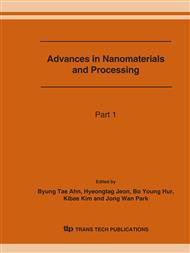p.1377
p.1381
p.1385
p.1389
p.1393
p.1397
p.1401
p.1405
p.1409
Microstructural Evolution during Annealing of 5052 Al Alloy Deformed at Cryogenic Temperature
Abstract:
The activation energy for recovery and recrystallization was calculated using DSC data. The annealing below 250°C resulted in the bimodal grain size distribution, while that above 300°C resulted in the uniform distribution of coarse grains. The formation of a bimodal microstructure would be responsible for the good combination of uniform elongation and tensile strength. Additionally, the little variation of hardness for different annealing time at 300°C also indicated that mechanical properties of deformed and annealed 5052 Al alloy were significantly influenced by the volume fraction of recrystallized grains rather than the coarsening of recrystallized grains.
Info:
Periodical:
Pages:
1393-1396
Citation:
Online since:
June 2007
Authors:
Keywords:
Price:
Сopyright:
© 2007 Trans Tech Publications Ltd. All Rights Reserved
Share:
Citation:


